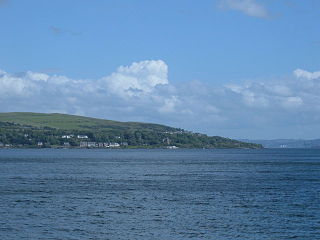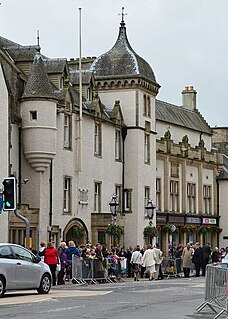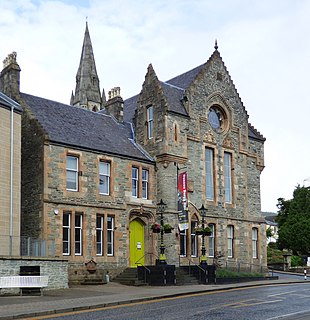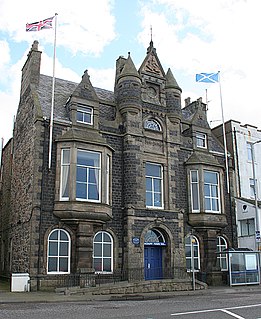
Argyll and Bute is one of 32 unitary authority council areas in Scotland and a lieutenancy area. The current Lord-Lieutenant for Argyll and Bute is Jane Margaret MacLeod. The administrative centre for the council area is in Lochgilphead at Kilmory Castle, a 19th-century Gothic Revival building and estate. The current Council leader is Councillor Robin Currie, a councillor for Kintyre and the Islands.

Dunoon is the main town on the Cowal peninsula in the south of Argyll and Bute, Scotland. It is located on the western shore of the upper Firth of Clyde, to the south of the Holy Loch and to the north of Innellan. As well as forming part of the council area of Argyll and Bute, Dunoon also has its own community council. Dunoon was a burgh until 1976.

Dunbartonshire or the County of Dumbarton is a historic county, lieutenancy area and registration county in the west central Lowlands of Scotland lying to the north of the River Clyde. Dunbartonshire borders Perthshire to the north, Stirlingshire to the east, Lanarkshire and Renfrewshire to the south, and Argyllshire to the west. The boundaries with Lanarkshire and Stirlingshire are split in two owing to the existence of an exclave around Cumbernauld.

Helensburgh is an affluent coastal town in Argyll and Bute council area, Scotland, sitting at the intersection of the Firth of Clyde, East Clyde and the Gareloch. It has its own Community Council. Until local government reorganisation in 1996, Helensburgh was in Dumbarton District and Strathclyde Region; prior to 1975 it was a small burgh with its own town council within Dunbartonshire.

Kilcreggan is a village on the Rosneath peninsula in Argyll and Bute, West of Scotland.

Cove is a village on the south-west coast of the Rosneath peninsula, on Loch Long, in Argyll and Bute, West of Scotland.

Dumbarton was a local government district in the Strathclyde region of Scotland from 1975 to 1996, lying to the north-west of the regional capital Glasgow.

Sir Charles William Cayzer, 1st Baronet was a British businessman and Conservative Party politician.
Hermitage Academy is a non-denominational secondary school in Helensburgh, Argyll and Bute, Scotland. It is one of two secondary schools in the Helensburgh area and is currently the largest secondary school in Argyll and Bute.

The Chambers Institution is a municipal structure in the High Street in Peebles, Scotland. The structure, which was designed to accommodate a library, a museum, an art gallery and Peebles Burgh Hall, is a Category A listed building.

The Rosneath Peninsula is a peninsula in Argyll and Bute, West of Scotland. Formerly in the historic county of Dunbartonshire, it is formed on its eastern shore from the confluence of the Firth of Clyde with the Gare Loch, and of the Clyde with Loch Long to the west.

Dunoon Burgh Hall is a municipal structure in Argyll Street, Dunoon, Scotland. The structure, which is used as an events venue, is a Category B listed building.

Barrhead Burgh Hall, also known as Barrhead Burgh Court Hall and Burgh Chambers and as the James McGuire Building, is a municipal complex in Main Street, Barrhead, East Renfrewshire, Scotland. The complex was the headquarters of Barrhead Burgh Council. It consists of two distinct buildings separated by an iron gate: Barrhead Burgh Court Hall, which is a Category C listed building, and, Barrhead Burgh Chambers, which is also a Category C listed building, although, as a group, they are listed at Category B.

Rothesay Town Hall and County Buildings is a former municipal building in Castle Street, Rothesay, Scotland. The structure, which was the meeting place of Rothesay Burgh Council and of Bute County Council, is a Category B listed building.

Macduff Town Hall is a municipal building in Shore Street, Macduff, Aberdeenshire, Scotland. The structure, which was the meeting place of Macduff Burgh Council, is a Category B listed building.

The Municipal Buildings are based on the north side of Princes Street East in Helensburgh, Scotland. The structure, which served as the meeting place of Helensburgh Burgh Council, is a Category B listed building.

Inverurie Town Hall is a municipal building in the Market Place in Inverurie, Scotland. The structure, which served as the meeting place of Inverurie Burgh Council, is a Category B listed building.

Craig Ailey is a villa at Cove, originally named Italian Villa. The site above a craig (cliff) gives views over the Firth of Clyde and its junction with Loch Long. It was designed in 1850 by Alexander Thomson, and built around 1852 by his client the builder and developer John McElroy, who had feued land in the Cove and Kilcreggan area from the 8th Duke of Argyll. Access to the house is by South Ailey Road. The house, on top of the craig above Craigrownie Cottage, can be seen from Shore Road.

Banchory Town Hall is a municipal structure in the High Street, Banchory, Aberdeenshire, Scotland. The structure is primarily used as a community events venue.

Campbeltown Town Hall is a municipal structure in Main Street in Campbeltown, Argyll and Bute, Scotland. The structure, which is used as a community events venue, is a Category B listed building.




















